Your fitness band screen’s longevity depends on premium materials like Gorilla Glass and polycarbonate that resist scratches and impacts. You’ll want IP67 or IP68 water resistance ratings to prevent moisture damage, while TPU overlays absorb daily shocks. Handle your device gently during removal and avoid high-risk activities like rock climbing. Curved edges and low-profile designs minimize accidental bumps, while proper sealing prevents dust ingress that compromises display clarity over time.
Material Selection for Enhanced Screen Protection
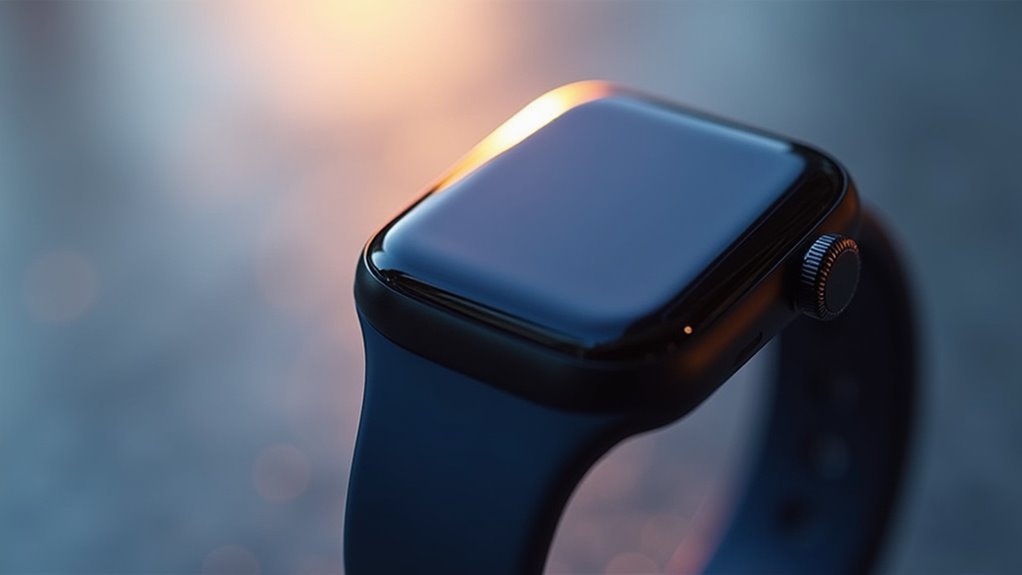
The durability of your fitness band’s screen depends heavily on the materials manufacturers choose during construction. Polycarbonate stands out as a top choice for screen components due to its exceptional impact resistance and lightweight properties.
You’ll find it maintains optical clarity while resisting cracks and shattering under stress.
Gorilla Glass offers superior scratch resistance through its chemically strengthened composition, considerably extending your screen’s lifespan compared to standard materials. The ion-exchange strengthening process helps it withstand minor impacts without compromising touch sensitivity.
Supporting materials like TPU provide flexible overlays that absorb shocks and prevent micro-abrasions, while stainless steel housing protects screen edges from chipping.
Silicone components add shock absorption and environmental sealing, creating thorough protection for your device’s display. Many manufacturers now incorporate recycled materials to reduce environmental impact while maintaining the protective qualities essential for long-lasting fitness tracker screens.
Impact Resistance and Mechanical Stress Testing
You’ll need rigorous testing methods to guarantee your fitness band screen can withstand daily impacts and mechanical stress.
Ballistic pendulum testing reveals how much energy your screen absorbs during sudden impacts, while bending and twisting evaluations show whether it’ll survive arm movements and accidental flexing.
These assessments follow strict structural integrity standards that determine if your device can maintain functionality through months of active use. Professional testing labs use a force gauge to measure the exact pressure required to compromise screen integrity during durability assessments.
Ballistic Pendulum Testing Methods
When evaluating fitness band screen durability, ballistic pendulum testing offers a precise methodology for measuring impact resistance under controlled conditions.
You’ll find this approach particularly effective because it converts kinetic energy into measurable potential energy, allowing accurate assessment of your screen’s resilience.
The testing setup involves various launcher configurations that let you adjust impact speeds and angles to simulate real-world scenarios.
You can select different projectiles to replicate specific impact types your fitness band might encounter during daily use.
Motion detectors and sensors enhance your data collection accuracy, while the pendulum’s swing measurements reveal how well your screen withstands sudden impacts.
This method’s strength lies in its repeatability—you’ll get consistent results that help identify stress points and potential failure modes in your screen components. The complete testing procedure typically requires 2-3 hours of laboratory time to ensure comprehensive evaluation of impact resistance across multiple test scenarios.
Bending and Twisting Evaluation
Building upon impact testing foundations, bending and twisting evaluation reveals how your fitness band screen responds to the daily mechanical stresses it’ll encounter on your wrist.
You’ll need thorough testing that measures flexural strength and torsional stress to understand your screen’s limits. Cyclic loading tests simulate repeated wrist movements, while fatigue testing shows long-term performance under continuous mechanical stress.
Material selection drives durability—flexible OLEDs and advanced substrates handle bending better than rigid alternatives. Manufacturing techniques like flexible substrate technology enhance resistance, while design innovations including reinforced edges provide extra protection.
These comprehensive assessments help identify potential failure points within the screen assembly before devices reach consumers, enabling manufacturers to optimize designs for maximum reliability.
- Flexural strength testing – Determines maximum bending force before screen failure
- Torsional stress evaluation – Measures twisting resistance during wrist rotation
- Cyclic loading assessment – Simulates thousands of daily wrist movements
Structural Integrity Assessment Standards
Since fitness band screens face daily impacts from doorframes, exercise equipment, and accidental drops, manufacturers rely on rigorous structural integrity assessment standards to guarantee your device survives real-world punishment.
The IK rating system, ranging from IK00 to IK10, defines impact resistance levels specifically for electronic products like fitness trackers. Manufacturers use ballistic pendulum tests with steel balls to measure energy absorption, while drop tests simulate real accidents from various heights.
Your screen’s durability depends on mechanical stress testing that evaluates scratch resistance, hardness, and environmental factors. Advanced designs incorporate multilayered protectors that enhance resistance by providing superior structural support against repeated impacts.
Standards like EN 62-262 and ASTM frameworks facilitate consistent testing protocols. These assessments analyze how forces distribute across your screen’s surface, helping manufacturers select ideal materials like tempered glass or TPU that’ll withstand your active lifestyle.
Environmental Durability Under Extreme Conditions
Although fitness bands face countless environmental challenges throughout their lifespan, their screens must withstand extreme conditions that would destroy ordinary electronic displays.
You’ll find that manufacturers use specialized polymer composites and heat-resistant glass like Gorilla Glass or sapphire to prevent warping and discoloration when temperatures soar. These screens undergo rigorous thermal cycling tests, simulating rapid temperature changes from -20°C to 60°C to guarantee they remain operational.
Your fitness band’s screen also features sealed assemblies that prevent dust ingress and maintain display clarity during outdoor activities. Toughened glass and flexible OLED displays resist impacts better than standard materials, while shock-absorbent layers protect against mechanical stress. Many devices fail after just 9-13 months due to inadequate protection against sweat exposure and repeated impacts in demanding work environments.
- Heat-resistant materials prevent screen degradation during high-temperature exposure
- Sealed dust-proof assemblies maintain clarity in harsh outdoor environments
- Impact-resistant displays withstand drops and mechanical shocks during activities
Water Resistance and Moisture Protection Standards
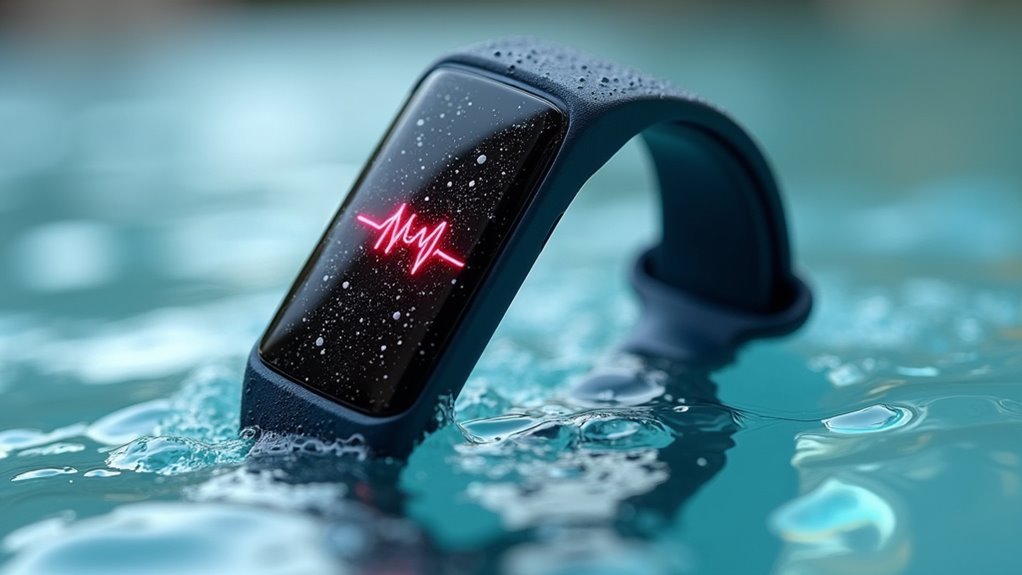
When you’re choosing a fitness band, you’ll encounter IP rating standards that determine how well your device can withstand water and dust exposure.
These ratings directly impact your screen’s longevity since moisture infiltration is one of the primary causes of display failure and internal component damage.
Understanding these protection standards helps you select a device that’ll maintain its screen quality through your sweatiest workouts and unexpected weather encounters. Prolonged exposure to water increases stress on gaskets and seals, which can compromise the protective barriers that keep moisture away from sensitive screen components.
IP Rating Standards
Your fitness band’s ability to withstand water and moisture directly impacts how long its screen will last, and understanding IP rating standards helps you choose a device that matches your lifestyle demands.
IP ratings use two digits to classify protection levels – the first indicates dust resistance, while the second measures water protection.
For fitness bands, you’ll commonly see ratings like IP67, IP68, and IPX variants. IP67 protects against water immersion up to one meter for 30 minutes, while IP68 offers superior protection for deeper, longer submersion. IPX ratings focus solely on water resistance without dust protection.
Official IP ratings require testing by certified companies to ensure accurate protection classifications for your device.
- IP67/IP68: Complete dust and water protection for swimming and outdoor activities
- IPX4-IPX6: Water-only protection ranging from splash resistance to powerful water jets
- Higher ratings: Reduced corrosion risk and extended screen lifespan through better moisture barriers
Moisture Damage Prevention
Since moisture poses the greatest threat to fitness band screen longevity, effective moisture damage prevention requires a multi-layered approach combining physical barriers, material selection, and protective coatings.
You’ll want devices with silicone or rubber seals that create watertight barriers around vulnerable points like buttons and charging ports. Hydrophobic coatings repel water from screens while waterproof adhesives maintain structural integrity when wet.
Design matters too—look for bands that allow easy drying and minimize water entry points. Keep in mind that sealing material age can compromise water resistance over time, reducing the effectiveness of these protective measures.
While ATM ratings indicate static pressure resistance, remember they don’t account for dynamic pressure from movement. For maximum protection, choose devices meeting ISO 22810:2010 standards and maintain them properly by drying after water exposure and storing in cool, dry conditions.
User Behavior Patterns and Wear Prevention
The way you handle your fitness band directly impacts how long its screen will last. Repeated impacts from hitting surfaces degrade screen durability over time, making gentle handling essential.
You’ll want to be careful when taking off and putting on your device to reduce accidental bump risk. Consider removing your band during high-risk activities like rock climbing, heavy weightlifting, or gardening. These situations increase the chances of screen contact with hard surfaces.
Walking and stationary workouts present lower risk compared to dynamic sports with frequent arm motion. The durability of the device is an important factor when selecting a fitness tracker for your specific activities.
- Choose low-impact activities like walking over high-contact sports when possible
- Remove your fitness band before weightlifting, rock climbing, or gardening activities
- Practice gentle handling during daily removal and attachment to prevent accidental impacts
Ergonomic Design Features That Reduce Screen Damage
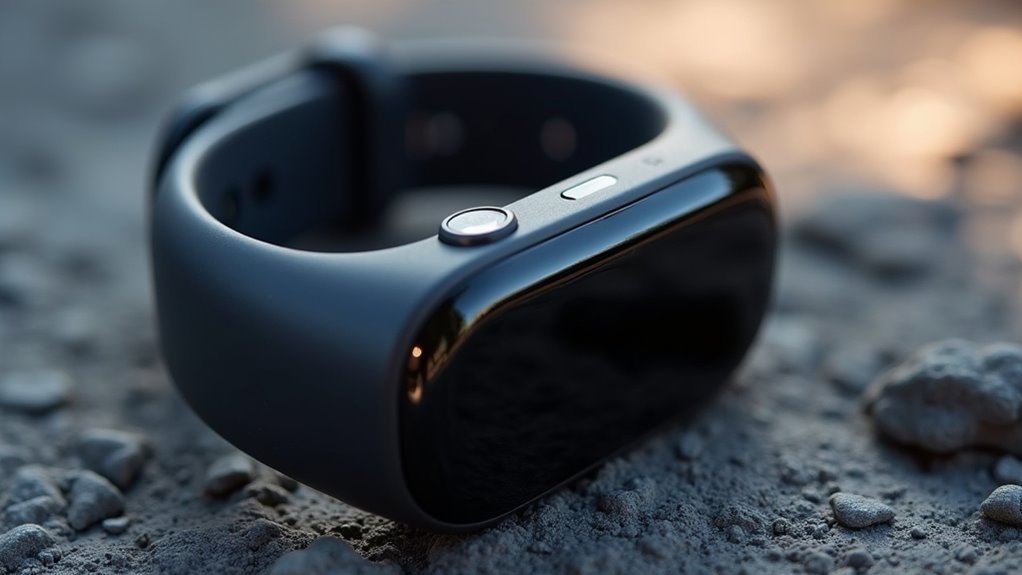
Beyond how you use your device, manufacturers build specific design elements into fitness bands that naturally protect screens from damage.
Curved edges with large radii minimize accidental pressure points while allowing your device to lay flush against your body, reducing snagging and abrasion. The low-profile design limits protrusions that can bump surfaces, and longitudinal placement on your wrist minimizes direct impact exposure.
Secure, adjustable clasps keep your band snug without shifting, preventing drops and screen hits. Manufacturers position screens inward or on top of your wrist to lower exposure to external hazards.
Material selection plays a vital role—silicone bands absorb shocks, scratch-resistant coatings protect against wear, and raised bezels shield your screen from direct surface contact. Wrist wearables require increased precision due to smaller anatomical landmarks, making careful component placement crucial for durability.
Health-Safe Materials and Long-Term Reliability
Material selection directly impacts both your health and your fitness band’s lifespan, making it essential to understand what touches your skin daily.
Thermoplastic polyurethane (TPU) offers hypoallergenic properties that reduce skin irritation while providing excellent abrasion resistance for long-term durability. However, you’ll want to avoid fluoroelastomers despite their dirt-repelling qualities, as these contain persistent PFAS chemicals that pose health concerns.
Ion-exchanged glass screens, like Apple’s Ion-X, deliver superior scratch resistance by replacing sodium ions with larger potassium ions, increasing surface hardness.
While sapphire crystal provides exceptional scratch resistance, it’s more prone to cracking under impact. Many users recommend adding screen protectors as an additional safeguard to extend your device’s display longevity.
- Choose TPU bands for hypoallergenic properties and flexibility
- Select ion-exchanged glass screens for balanced durability and impact resistance
- Avoid fluoroelastomer materials containing harmful “forever chemicals”
Frequently Asked Questions
How Often Should I Replace My Fitness Band Screen Protector?
You should replace your fitness band screen protector every 6-12 months, depending on usage. Replace it sooner if you notice scratches, cracks, clouding, discoloration, or peeling that impacts readability.
Can I Repair a Cracked Fitness Band Screen Myself?
You can repair a cracked fitness band screen yourself using specialized tools like fine-tip tweezers and small screwdrivers. However, you’ll need patience, proper adhesive, and careful handling of delicate ribbon cables.
Do Fitness Band Screens Become Less Responsive Over Time?
Yes, your fitness band screen will become less responsive over time. You’ll notice decreased touch sensitivity from physical wear, software lag, dirt accumulation, and display degradation that naturally occurs with regular use.
Which Fitness Band Brands Have the Longest Lasting Screens?
You’ll find Garmin, Apple Watch, and Amazfit offer the longest-lasting screens. They use premium materials like sapphire glass and stainless steel casings that resist scratches and impacts better than budget alternatives.
How Much Does Professional Fitness Band Screen Repair Typically Cost?
You’ll typically pay $40-$100 for professional fitness band screen repair. Basic models cost around $40-$50, while premium devices like Apple Watch start at $99.99, depending on your specific model and local service provider.
In Summary
You’ll maximize your fitness band’s screen lifespan by choosing devices with premium materials like Gorilla Glass and reinforced polymers. Don’t ignore impact resistance ratings and water protection standards when you’re shopping. You can prevent premature wear by adjusting band tightness properly and avoiding harsh chemicals during cleaning. Look for ergonomic designs that minimize accidental impacts, and you’ll guarantee your device maintains both functionality and safety throughout years of active use.

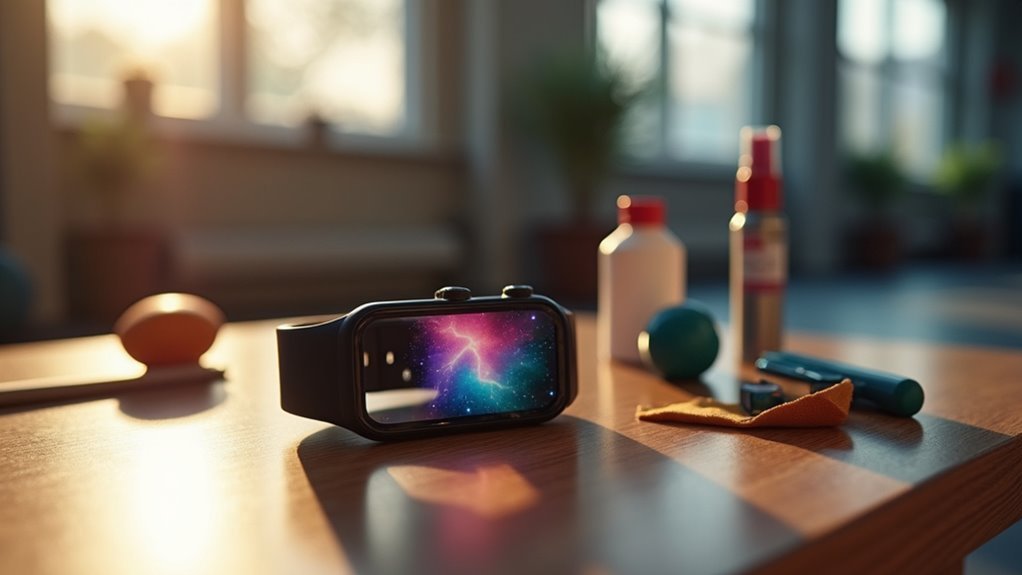

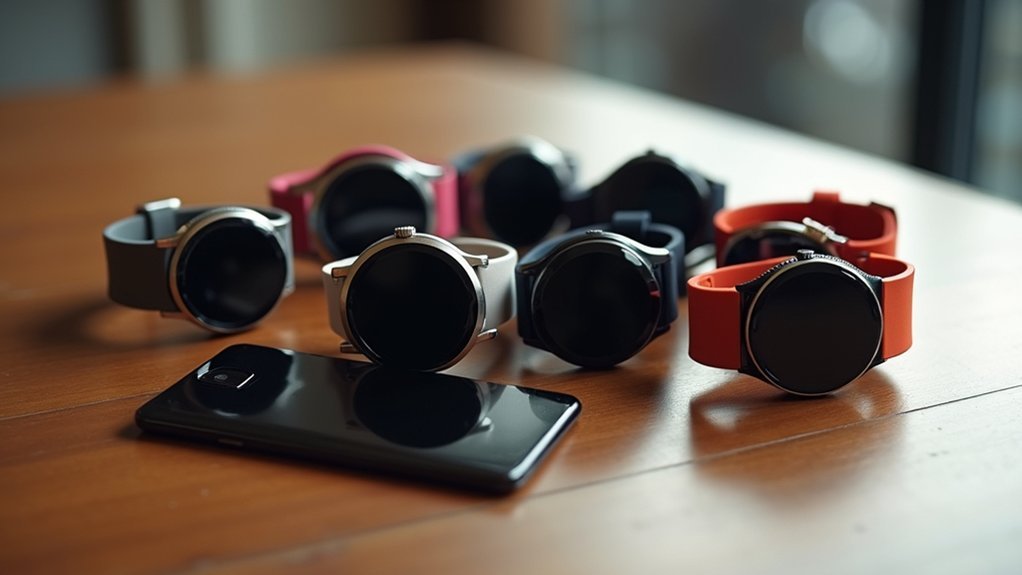
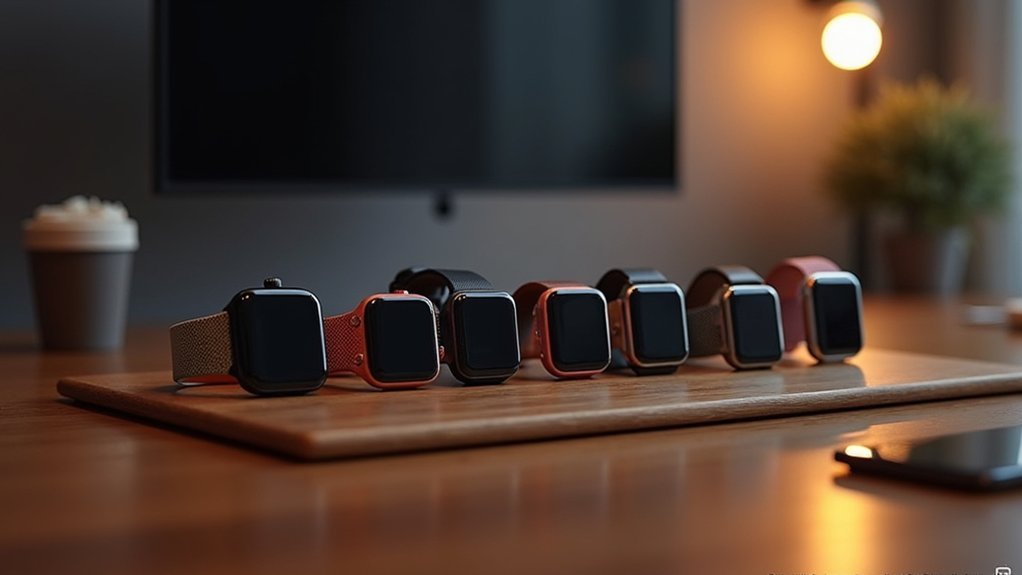
Leave a Reply